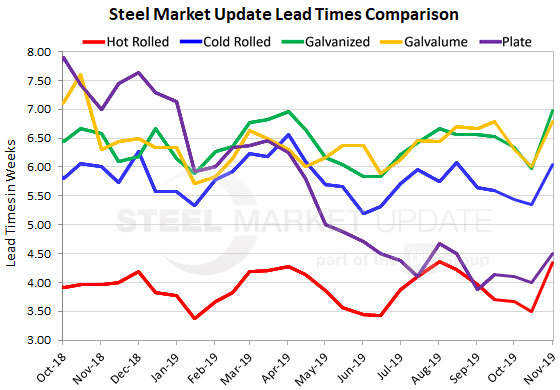SMU Data and Models

Steel Mill Lead Times: Mills Getting Busier?
Written by Tim Triplett
November 10, 2019
Mill lead times for spot orders of flat rolled showed early signs of lengthening in the first week of November following the $40 per ton price increase announcements Oct. 24-25. Lead times for steel delivery are a measure of demand at the mill level. Thus, this data suggests the mills are getting busier as buyers step up to place orders ahead of increasing prices.
The average lead time for hot rolled is now up to nearly four and a half weeks, cold rolled is over six weeks and coated steels are nearly seven weeks. Plate lead times are up to four and a half weeks, according to data gathered by Steel Market Update on Monday and Tuesday of this past week.
Hot rolled lead times now average 4.34 weeks, up from 3.50 weeks in mid-October. The average cold rolled lead time has increased to 6.04 weeks from 5.35 weeks. The average lead time for galvanized has jumped by a full week to 6.98 from 5.97 weeks, while the lead time for spot orders of Galvalume is now up to 6.78 weeks. Lead times for spot orders of plate steel have also increased to an average of 4.50 weeks. Lead times for most products are now about the same or slightly longer than they were at this time last year.
Flat rolled producers announced a second round of price hikes on Thursday for a total increase of $80 per ton in the past two weeks in the hope of reversing the downtrend in steel prices. Plate producers notified customers this week of their first $40 per ton increase. While it is too soon to tell how much of the increases the mills will collect, the announcements appear to be having some effect. In addition to the longer lead times, SMU data shows the current benchmark price for hot rolled at $490 per ton, up from $470 prior to the first increase.

Note: These lead times are based on the average from manufacturers and steel service centers who participated in this week’s SMU market trends analysis. Our lead times do not predict what any individual may get from any specific mill supplier. Look to your mill rep for actual lead times. Our lead times are meant only to identify trends and changes in the marketplace. To see an interactive history of our Steel Mill Lead Times data, visit our website here.

Tim Triplett
Read more from Tim TriplettLatest in SMU Data and Models

SMU’s June at a glance
A look at SMU data for the month of June.

SMU Survey: Buyers’ Sentiment rebounds from multi-year low
Both of SMU’s Steel Buyers’ Sentiment Indices edged higher this week. Current Sentiment rebounded from a near five-year low, while Future Sentiment rose to a two-month high

SMU flat-rolled market survey results now available
SMU’s latest steel buyers market survey results are now available on our website to all premium members.

SMU Survey: Sheet lead times pull back after early-June blip, plate holds
Following the uptick seen two weeks ago, lead times eased this week for all four sheet products tracked by SMU, while plate lead times held steady, according to this week’s market survey.

SMU Survey: Pricing power abruptly shifts to steel buyers
The majority of steel buyers responding to our latest market survey say domestic mills are more willing to talk price on sheet and plate products than they were earlier this month. Sheet negotiation rates rebounded across the board compared to early June, while our plate negotiation rate hit a full 100%.
